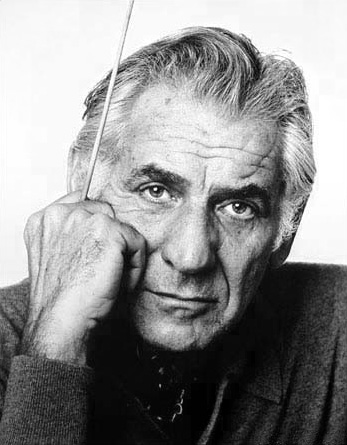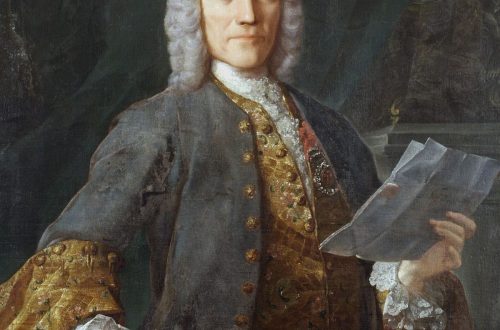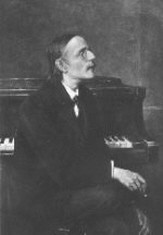
Leonard Bernstein |
Leonard Bernstein
Well, isn’t there a secret in it? He is so lit on the stage, so given to the music! Orchestras love it. R. Celletti
The activities of L. Bernstein are striking, first of all, with their diversity: a talented composer, known throughout the world as the author of the musical “West Side Story”, the largest conductor of the XNUMXth century. (he is called among the most worthy successors of G. Karayan), a bright music writer and lecturer, able to find a common language with a wide range of listeners, pianist and teacher.
Becoming a musician Bernstein was destined by fate, and he stubbornly followed the chosen path, despite the obstacles, sometimes very significant. When the boy was 11 years old, he began taking music lessons and after a month he decided that he would be a musician. But the father, who considered music an empty pastime, did not pay for the lessons, and the boy began to earn money for his studies himself.
At the age of 17, Bernstein entered Harvard University, where he studied the art of composing music, playing the piano, listening to lectures on the history of music, philology and philosophy. After graduating from the university in 1939, he continued his studies – now at the Curtis Institute of Music in Philadelphia (1939-41). An event in Bernstein’s life was a meeting with the largest conductor, a native of Russia, S. Koussevitzky. An internship under his leadership at the Berkshire Music Center (Tanglewood) marked the beginning of a warm friendly relationship between them. Bernstein became Koussevitzky’s assistant and soon became assistant conductor of the New York Philharmonic Orchestra (1943-44). Prior to this, having no permanent income, he lived on funds from random lessons, concert performances, taper work.
A happy accident hastened the beginning of a brilliant conductor’s career Bernstein. The world famous B. Walter, who was supposed to perform with the New York Orchestra, suddenly fell ill. The permanent conductor of the orchestra, A. Rodzinsky, was resting outside the city (it was Sunday), and there was nothing left but to entrust the concert to a novice assistant. After spending the whole night studying the most difficult scores, Bernstein the next day, without a single rehearsal, appeared before the public. It was a triumph for the young conductor and a sensation in the music world.
From now on, the largest concert halls in America and Europe opened in front of Bernstein. In 1945, he replaced L. Stokowski as chief conductor of the New York City Symphony Orchestra, conducted orchestras in London, Vienna, and Milan. Bernstein captivated the listeners with his elemental temperament, romantic inspiration, and depth of penetration into the music. The artistry of the musician truly knows no limits: he conducted one of his comic works … “without hands”, controlling the orchestra only with facial expressions and glances. For more than 10 years (1958-69) Bernstein served as principal conductor of the New York Philharmonic until he decided to devote more time and energy to composing music.
Bernstein’s works began to be performed almost simultaneously with his debut as a conductor (the vocal cycle “I Hate Music”, the symphony “Jeremiah” on a text from the Bible for voice and orchestra, the ballet “Unloved”). In his younger years, Bernstein prefers theatrical music. He is the author of the opera Unrest in Tahiti (1952), two ballets; but his greatest success came with four musicals written for theaters on Broadway. The premiere of the first of them (“In the City”) took place in 1944, and many of its numbers immediately gained popularity as “militants”. The genre of Bernstein’s musical goes back to the very roots of American musical culture: cowboy and black songs, Mexican dances, sharp jazz rhythms. In “Wonderful City” (1952), withstood more than half a thousand performances in one season, one can feel the reliance on the swing – jazz style of the 30s. But the musical is not purely an entertainment show. In Candide (1956), the composer turned to the plot of Voltaire, and West Side Story (1957) is nothing more than the tragic story of Romeo and Juliet, transferred to America with its racial clashes. With its drama, this musical approaches the opera.
Bernstein writes sacred music for choir and orchestra (oratorio Kaddish, Chichester Psalms), symphonies (Second, Age of Anxiety – 1949; Third, dedicated to the 75th anniversary of the Boston Orchestra – 1957), Serenade for string orchestra and percussion on Plato’s dialogue “Symposium” ( 1954, a series of table toasts praising love), film scores.
Since 1951, when Koussevitzky died, Bernstein took his class at Tanglewood and began teaching at the University of Weltham (Massachusetts), lecturing at Harvard. With the help of television, the audience of Bernstein – an educator and educator – transcended the boundaries of any university. Both in lectures and in his books The Joy of Music (1959) and The Infinite Variety of Music (1966), Bernstein strives to infect people with his love for music, his inquisitive interest in it.
In 1971, for the grand opening of the Center for the Arts. J. Kennedy in Washington Bernstein creates the Mass, which caused very mixed reviews from critics. Many were confused by the combination of traditional religious chants with elements of spectacular Broadway shows (dancers participate in the performance of the Mass), songs in the style of jazz and rock music. One way or another, the breadth of Bernstein’s musical interests, his omnivorousness and complete absence of dogmatism were manifested here. Bernstein visited the USSR more than once. During the 1988 tour (on the eve of his 70th birthday) he conducted the International Orchestra of the Schleswig-Holstein Music Festival (FRG), consisting of young musicians. “In general, it is important for me to address the theme of youth and communicate with it,” the composer said. “This is one of the most important things in our lives, because youth is our future. I like to pass on my knowledge and feelings to them, to teach them.”
K. Zenkin
Without in any way disputing Bernstein’s talents as a composer, pianist, lecturer, one can still say with confidence that he owes his fame primarily to the art of conducting. Both the Americans and the music lovers in Europe called for Bernstein, the conductor, first of all. It happened in the mid-forties, when Bernstein was not yet thirty years old, and his artistic experience was negligible. Leonard Bernstein received a comprehensive and thorough professional training. At Harvard University, he studied composition and piano.
At the famous Curtis Institute, his teachers were R. Thompson for orchestration and F. Reiner for conducting. In addition to this, he improved under the guidance of S. Koussevitzky – at the Berkshire Summer School in Tanglewood. At the same time, in order to earn a living, Lenny, as his friends and admirers still call him, was hired as a pianist in a choreographic troupe. But he was soon fired, because instead of the traditional ballet accompaniment he forced the dancers to practice to the music of Prokofiev, Shostakovich, Copland and his own improvisations.
In 1943, Bernstein became an assistant to B. Walter in the New York Philharmonic Orchestra. Soon he happened to replace his ailing leader, and since then he began to perform with increasing success. At the end of 1E45, Bernstein had already led the New York City Symphony Orchestra.
Bernstein’s European debut took place after the end of the war – at the Prague Spring in 1946, where his concerts also attracted general attention. In those same years, listeners also got acquainted with the first compositions of Bernstein. His symphony “Jeremiah” was recognized by critics as the best work of 1945 in the United States. The following years were marked for Bernstein by hundreds of concerts, tours on different continents, premieres of his new compositions and continuous growth in popularity. He was the first among American conductors to stand at the La Scala in 1953, then he performs with the best orchestras in Europe, and in 1958 he leads the New York Philharmonic Orchestra and soon makes a triumphant tour of Europe with him, during which he performs in USSR; finally, a little later, he becomes the leading conductor of the Metropolitan Opera. Tours at the Vienna State Opera, where Bernstein made a real sensation in 1966 with his interpretation of Verdi’s Falstaff, finally secured the artist’s worldwide recognition.
What are the reasons for his success? Anyone who has heard Bernstein at least once will easily answer this question. Bernstein is an artist of spontaneous, volcanic temperament who captivates listeners, makes them listen to music with bated breath, even when his interpretation may seem unusual or controversial to you. The orchestra under his direction plays music freely, naturally and at the same time unusually intense – everything that happens seems to be improvisation. The conductor’s movements are extremely expressive, temperamental, but at the same time completely accurate – it seems that his figure, his hands and facial expressions, as it were, radiate the music that is born before your eyes. One of the musicians who visited the performance of Falstaff conducted by Bernstein admitted that already ten minutes after the start he stopped looking at the stage and did not take his eyes off the conductor – the whole content of the opera was reflected in it so completely and accurately. Of course, this unbridled expression, this passionate outburst is not uncontrollable – it achieves its goal only because it embodies the depth of intellect that allows the conductor to penetrate the composer’s intention, to convey it with the utmost integrity and authenticity, with a high power of experience.
Bernstein retains these qualities even when he acts simultaneously as a conductor and pianist, performing concertos by Beethoven, Mozart, Bach, Gershwin’s Rhapsody in Blue. Bernstein’s repertoire is huge. Only as head of the New York Philharmonic, he performed almost all classical and modern music, from Bach to Mahler and R. Strauss, Stravinsky and Schoenberg.
Among his recordings are almost all the symphonies of Beethoven, Schumann, Mahler, Brahms, and dozens of other major works. It is difficult to name such a composition of American music that Bernstein would not perform with his orchestra: for several years he, as a rule, included one American work in each of his programs. Bernstein is an excellent interpreter of Soviet music, especially the symphonies of Shostakovich, whom the conductor considers “the last great symphonist.”
Peru Bernstein-composer owns works of different genres. Among them are three symphonies, operas, musical comedies, the musical “West Side Story”, which went around the stages of the whole world. Lately, Bernstein has been striving to devote more time to composition. To this end, in 1969 he left his post as head of the New York Philharmonic. But he expects to continue performing periodically with the ensemble, which, celebrating his remarkable achievements, awarded Bernstein the title of “Lifetime Conductor Laureate of the New York Philharmonic.”
L. Grigoriev, J. Platek, 1969





